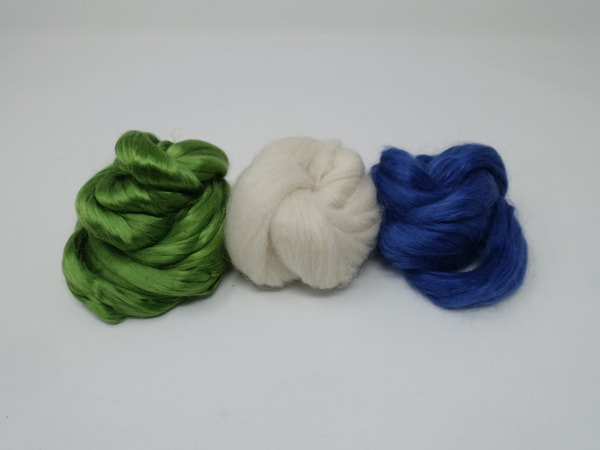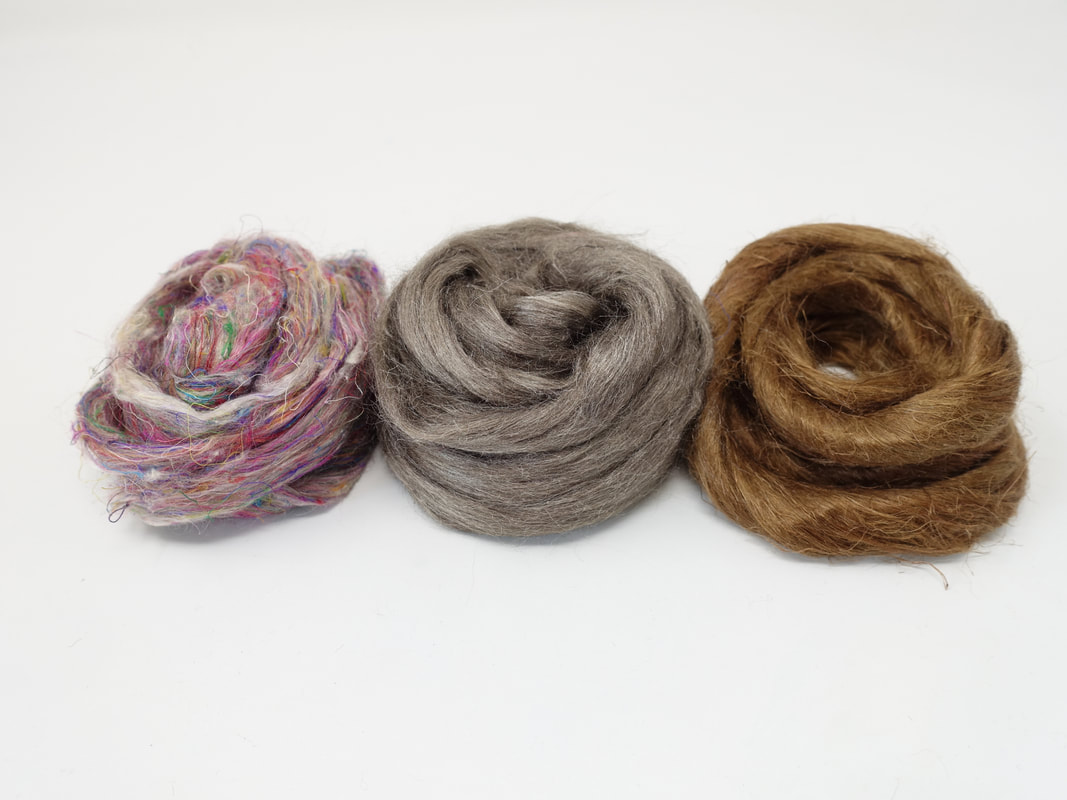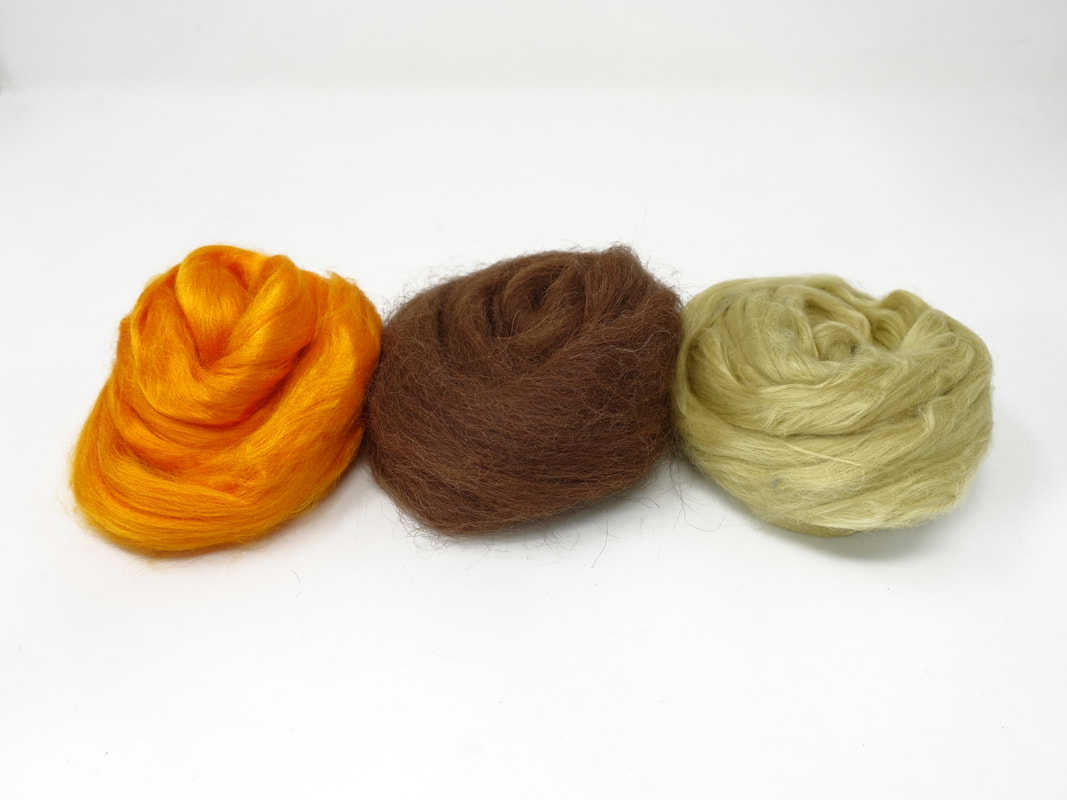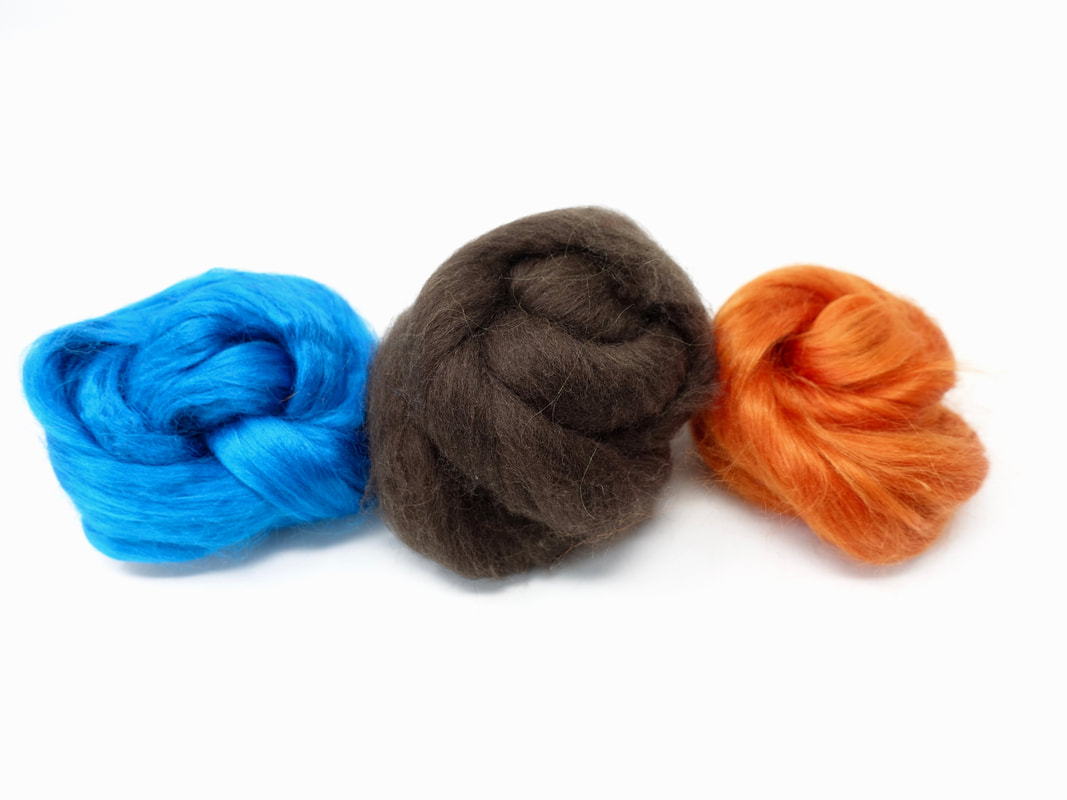|
Firstly, my apologies for the delay in getting this post up. I've had a cold for the past 2 weeks, and no one wants to listen to me explaining how to spin a fibre accompanied by constant sniffing! AS ever, this post contains spoilers. If you want to try any of the fibres from last month, or would like more of any of the fibres included, they're now all available to buy in the shop. The first fibre to start off with from this round of the club is Llama. Llamas are a member of the camelid family, like Alpacas, but larger in size. They produce a coat that is very similar to alpaca. This Llama is graded at 20-21 microns, which is at the finer end of the scale of the fibre produced commercially. It's a long stapled fibre, with very little crimp, as a result it won't spin in a yarn with much bounce and elasticity. If you spin from the end of the combed top you'll get a smooth, lustrous yarn. Alternatively spin from the fold to get a fluffier yarn. Next we've got Mulberry Silk. This is the most lustrous of all the silk types, which to me means that I want spin it in a way that maximises the shine. I like spinning it straight from the end of the combed top, in the video I give you a few hints on how to do this successfully, particularly if you usually end up with a jumbled mess off fibres. The final fibre in this month of the club is Ramie. This plant fibre comes from the nettle family; Boehmeria Nivea and Boehmeria Tenacissima. The outer pulp of the stem is removed, leaving behind the fibrous inner, which is then combed to remove all the shorter pieces of fibre, and any remaining pieces of outer stem. The fibre is processed China, before being dyed in Italy to Okeo-Tex 100 standards using renewable energy sources. It will spin in to a strong, smooth yarn, with a moderate amount of shine. As usual, this post will contain spoilers, so if you've not received your parcel you may want to come back and read this later. This is a new round of the club, and we'll be going back to re-visit a few fibres, but there are still plenty of new fibres to explore, and there are two of them in the parcels this month. If you liked the look of any of the fibres from last month the spare stock is now available to buy separately in the online shop. The first fibre I recommend you try in this round of parcels is Peduncle Silk. This naturally coloured brown silk is produced by the Tussah (Tasar) silk moth. It’s unusual because unlike other species it forms a little tail that pokes out of the end of the cocoon. That tail (or peduncle) is proceeded to form this fibre. It's a much more wool-like fibre than many of the other silks, and one of the easiest forms of silk to spin. I know lots of people loved this fibre in the Tour de Fleece Non-Wool Sampler. You can spin it straight from the end of the top, or break it in to chunks and spin it from the fold. The more textured nature of this fibre means the different drafting techniques doesn't alter the appearance of the yarn as much as it does with the shinier silks. Sari Silk fibre is created using the waste from the will weaving industry. It takes all the loom waste, and general off cuts, and cards them together to create this textured, recycled fibre. Historically this is the sort off fibre that would be described as Shoddy, but don't le the modern mutation put you off. This fibre will spin in to a beautifully textured fibre. You can spin using a short forward draw, but will need to use an inch-worm technique, or can go for a point of twist draft. Be sure to make sure you add enough twist, the shorter fibres in this blend will make a yarn that is likely to pill. This fibre adds real magic to blends as well. Due to the way that some of the fibres were originally dyed I'd recommend using caution when you wash your yarn for the first time. Wash it by itself, and check to see if you get any dye run off. If you do it's probably worth adding a splash of vinegar, and then heating it up either in the microwave, in a steamer, or just in a pan of water. That should set any loose dye, and mean you won't get any further problems. Just get in touch if you need any further help with this. The final fibre for this month is Flax Tow. Once we’ve turned this in to yarn this fibre becomes known as linen. This fibre is very strong, highly absorbent, and quick drying. It’s ideal for wearing in hot, humid weather. The first evidence of mankind processing linen for textiles comes from the area of modern day Georgia, around 36,000 years ago. Traditionally this is spun in the opposite direction to normal with an S twist (with your wheel going anticlockwise), but an article in the Flax edition of Ply magazine has made me question the need to do this. You will find it helpful to wet you front hand as you go along, this really does help to smooth the fibres and to hold the yarn together. We are spinning flax tow, these are shorter fibres that will naturally spin in to a more textured yarn that you would get if you were spinning from flax strick. Repeat the wetting and smoothing procedure as you ply your yarn. I recommend a gentle boil in a mild washing soda solution to soften the hand of this yarn once it is plied. I will start off by saying that this is the final parcel in this 3 month block of the club. Spaces are still available for the next round, and will be available until all the spaces are sold, or I ship the first parcel. We're visiting Germany for the inspiration this time, with one parcel featuring a green, blue, purple and brown colour palette, and the other featuring orange, yellow, browns and aqua. I do still have a few new fibres for the next round of the club... so even if you've been in the previous rounds you should still experience something new, and of course, the colours will be completely different! The first fibre I recommend trying in the parcel this month is Alpaca. It's probably the most similar to wool, so should be a reasonably relaxing spin. Alpaca's are in the camelid family, and native to South America. The micron count of this fibre is 24-26 microns, and classed as Baby Alpaca, but that doesn't necessarily mean that the fibre comes from young animals. As with sheep, the fibre that's produced is variable, but generally older animals produce coarser fibre. A traditional use for this fibre is as suiting fabric, producing a fabric with beautiful shine and drape. I like to spin this with a short forward draw from the end of the top, without too much twist, otherwise you end up with a yarn that's like string. The second fibre for the month is bamboo rayon. This is a synthesised plant fibre, and from a different source to the viscose fibre we spun in June. That viscose was from general plant sources, and processed in Germany. This fibre comes from bamboo, which is very ecologically friendly, but is processed in China. To me, the fibres do feel noticeably different, so I thought you might enjoy comparing them. You may also see this sort of fibre referred to as Viscose, but viscose is a specific type of rayon, only made from wood pulp. I like to spin this fibre from end of the combed top with a short forward draw, as that gives maximum shine and smoothness. If you struggle with the slippy fibres then switch to spinning from the fold. The final fibre in the parcels this month is cotton. this plant fibre is fine and very short stapled, and comes from the fluffy fibres that surround cotton seeds on the cotton plant. This cotton is grown in South America, and dyed in Italy. You can add a lot of twist to this fibre, and most people generally struggle with adding too little twist, rather than too much. You generally make thicker cotton yarns by combining multiple thin plies, and it's not a fibre that works well as thicker singles, you will get a lot of pilling, and a fluffy, unstable yarn. I can really recommend the Cotton edition of Ply magazine to learn more about this fibre. If you're spinning it on a wheel use the fastest ratio you have, and you are looking to draft using a modified form of long draw straight from the end of the combed sliver. Keep adding twist and pulling your hands apart until the lumps even out and you can't draft any further, this is the point at which your yarn has enough twist to hold it together. You can add lots of plying twist as well, this fibre can handle it! If you own any lightweight spindles this might be the ideal fibre to spindle spin, and if you own a quill for your wheel this is the perfect fibre to spin from the point. The July parcels for the Non-Wool Club have gone in the post, so don't carry on reading if you're a club member and don't want to see what's in your parcel. The spare fibre from last month is now in the shop for anyone to purchase. The first fibre for this month is Tussah Silk. If you've not spun silk before then this fibre is a great intriduction. Still shiny, still with a long staple length, but the fibres have slightly more texture so tend to draft more easily than Mulberry Silk. The silk worms that produce Tussah Silk are rather less fussy than the ones that produce mulberry silk. They can eat a wider variety of leaves, and as a result produce a fibre that is slightly coarser and with less lustre. The natural tannin from the oak leaves in their diet produces fibre that is naturally golden in colour. This type of silk can be very durable, but still comes with a fantastic shine. I like to spin it straight from the end of the combed top, keep a relaxed grip on the fibre to avoid pulling on both ends of the same staple, and to ensure you don't end up with a tangled mass of fibres. If you find it tricky then switch to spinning it from the fold, you can either use a short forward draw, or switch to a point of twist draw. This makes the yarn slightly less lustrous. How much twist to use is a matter of personal preference. I like a lower twist yarn as it stays softer and drapes better. However if you're spinning for weaving you may want more twist to reduce the effect of abrasion on the heddles. The second fibre for you to spin this month is Soyasilk. This is shiny like Silk, but has a much shorter staple length, more like spinning a fibre like Camel, Yak or Cashmere. You can spin it with a short forward draw, but you will have to concentrate hard to stop the fibre getting away from you. Try switching ti spinning from the sold with a point of twist draft and it all becomes much more relaxing! You might also see this fibre referred to as Soybean, this fibre is manmade, but from a natural source. Soya protein is processed in to fine filaments to make this combed top. It was invented by Henry Ford in 1937, and was primarily used for car upholstery, because its anti-UV properties mean it fades far less quickly than silk or viscose. The rise of true synthetic fibres meant it disappeared from production, but was revived in 1998 when interest in non-oil based fibres was starting to increase. Finally we have another short stapled fibre, but one that will be soft and fluffy. This fibre comes from goats, there’s no specific breed that produces cashmere fibre, instead any fibre that is graded at below 19 microns can be called cashmere. The name comes from Kashmir, which is the northernmost part of the Indian subcontinent. This fibre is graded at around 13 microns, unless you are lucky enough to ever spin Qiviut or Vicuna this is probably the finest fibre you will ever spin. Its short staple length can make this a challenging fibre, but it will handle having a large amount of twist and still remain soft. This cashmere is sourced from Mongolia.
You can spin this straight from the end of the combed top with a short forwards draw, but it's hard work, you can also spin with a point of twist draft straight from the end of the top, or you can spin it from the fold. Either way, this is a fibre that will handle higher levels of twist, and will still remain feeling soft. In fact if you don't use enough twist the short staple length will mean the yarn pills badly. If you've not received your parcel yet, then look away now! Are are the videos and fibre information to go alongside the June round of the Non-Wool Club. The spare fibre from previous rounds is now live in the Non-Wool section of the shop if any of the previous videos have wetted your appetite to try these fibres. We're on to a new 3 month block of this club, some fibres are ones we encountered last time, but others are brand new. I've started off with Viscose. This is a shiny fibre, in many ways similar to silk, but it's a manufactured cellulose fibre. The plant material is turned in to a pulp, and then forced through fine jets producing the fine stapled fibre. You may also see this fibre described as Rayon. The smooth, shiny nature of the fibres produces a yarn with very little memory or bounce so I think it's best suited to being spun more finely. I prefer to spin it straight from the end of the length of top to produce maximum shine, but you may like to try spinning it from the fold if you're struggling with the fibres getting away from you. The amount of twist will depend on your intended use, knitting yarns can use much less twist, but if you plan on weaving with it them add more twist as it will suffer from abrasion from the heddles and reed. The next fibre in this round of parcels is Ramie. This is another cellulose plant fibre, but not a manufactured fibre, this is a traditional base fibre like Linen (Flax) or Hemp. It comes from the nettle family; Boehmeria Nivea and Boehmeria Tenacissima. These plants grow incredibly quickly, they can reach a heigh of 2 or 3 metres and be harvested several times in a single year. When linen is processed you can remove the outer stem by hitting it, but this isn't possible with ramie. The inner stem is instead treated with lye (the same chemical used to make soap) and that dissolves the pulpy material, leaving behind the fibrous vascular bundles. The fibre is then combed to make the length of top we are spinning from. The fibre has a long staple length and develops a beautiful lustre when spun. Be sure to keep your hands well spaced, and don’t use too much twist or you’ll end up with string. This fibre blends beautifully and evenly and adds strength to your finished yarn. You can spin this one from the fold but it really does lead to a slightly hairy yarn, rather than one with beautiful smoothness and shine. It works better when spun more finely as it has no memory or bounce, but it does drape beautifully, and as with all bast fibres the more you handle and work it the softer it becomes. The final fibre is a new one for the club. Yak down is a very fine stapled fibre, at 17-19 microns this is nearly as soft as cashmere, and with many similar properties though is slightly shorter in staple length. The yak is collected when the animals moult, and is then commercially dehired to remove the diff guard hairs leaving behind the soft undercoat. The short staple length will be your biggest battle with this fibre, if you try to use a short forward draw you will continually feel as if you are having to grasp the fibres for grim death to stop them getting away from you. Switch to a point of twist draft and it will all become much easier. Don't panic if your yarn isn't super even, plying will make a huge difference to the final yarn. You can use lots of twist with this fibre, in fact lack of twist will produce a yarn that is likely to pill very quickly. If you over-ply your yarn slightly you will increase the bounce and memory, making this yarn ideal for things like hats and cowls. It will work well when spun more thickly, though thinner yarns are also beautiful in fibres of this type. And so to the final parcel of this round of the Non-Wool Club. The next 3 month round still has a few spaces, you can subscribe here. I still have a few new fibres to introduce to you, so this next round will hopefully be interesting for everyone, and of course the colour palettes are completely different. The May round features 2 different plant fibres, and a different form of silk. I've recommended you start off with the silk first, as it will be the most familiar to you. Muga Silk is an Indian form of silk, produced in Assam. It has a shimmering golden colour, with slight green undertone. It very much reminds me of the colour of the 9 carat wedding band that was my Grandmas. This silk will increase with lustre with every washing, the staple length is longer than Tussah Silk, and it really has a beautiful sheen and fineness. the staple length is longer than Tussah Silk, closer to the length of Mulberry Silk. The next fibre we have is cotton. Cotton is a plant fibre, but very different to any we've spun so far. It's very fine, and very short stapled. It's hard to over twist cotton, and to will still feel soft even when you add a lot of twist. Cotton work best when spun as a fine single, if you want a thicker yarn you usually combine multiple strands. I can really recommend the Cotton edition of Ply magazine to learn more about this fibre. Use the fastest ratio you have, and you are looking to draft using a modified form of long draw straight from the end of the combed sliver. Keep adding twist and pulling your hands apart until the lumps even out and you can't draft any further, this is the point at which your yarn has enough twist to hold it together. You can add lots of plying twist as well, this fibre can handle it! If you own any lightweight spindles this might be the ideal fibre to spindle spin, and if you own a quill for your wheel this is the perfect fibre to spin from the point. Our final fibre is flax. When spun this become linen thread. We're going to treat this exactly as we did the Hemp last month, so traditionally this is spun in the opposite direction to normal with an S twist (is your wheel going anticlockwise). You will find it helpful to wet you front hand as you go along, this really does help to smooth the fibres and to hold the yarn together. We are spinning flax tow, these are shorter fibres that will naturally spin in to a more textured yarn that you would get if you were spinning from flax strick. Just as with the Hemp I recommend a gentle boil in a mild washing soda solution to soften the hand of this yarn once it is plied. By now the UK parcels for the April Non-Wool Club have arrived, so I sat down and filmed some short video clips showing me spinning them. I am aware that these are probably not the most professionally shot videos in the world, but do hope you find them helpful. If you aren't a member of this club and are thinking about joining then I plan on opening up the next round of 3 month subscriptions at the start of May. The cost will be similar to the current prices for the club, though may alter slightly depending on the exact fibres I use. There will be some repeated fibres, but will be some new ones as well. These are the colours that are going to inspire the next round, if you're interested in joining then select the option on the poll below, I pre-order all the fibre required for this club before putting it on sale to make sure I have adequate supplies. So voting helps make sure I can meet demand. The colour options last time were inspired by the Italian landscape, and this time we're going to Spain. So with the admin out of the way, on to the videos and spinning hints. The first fibre that I recommend you start with this month is the mulberry silk. We spun 2 fibres last month that were similar, the tussah silk , and the viscose. If you still have your tussah silk, compare and contrast the 2 types, you may also find this old blogpost on types of silk useful. The main thing is to remember the staple length. Mulberry Silk is more like spinning a long wool, so a relaxed grip with you hand holding the fibre supply is crucial. I favour a short forward draw for my mulberry silk, without using too much twist, it maximises the shine and makes the yarn feel very soft and luxurious next to your skin. The next fibre I recommend you spin is the Ramie. Ramie is a bast plant fibre like linen, so hasn't needed the same level of chemical processing as that required for viscose of rayon. Ramie is processed from plants belonging to the nettle family; Boehmeria Nivea and Boehmeria Tenacissima. These plants grow incredibly quickly, they can reach a heigh of 2 or 3 metres and be harvested several times in a single year. When linen is processed you can remove the outer stem by hitting it, but this isn't possible with ramie, which is one of the things that contributes to the price. The inner stem is then treated with lye (the same chemical used to make soap) and that dissolves the pulpy material, leaving behind the fibrous vascular bundles. The fibre is then combed to make the length of top we're spinning from. The final fibre to spin this month is Hemp. This is a very ancient textile plant, one of the first to be spun in to yarn as long ago as 10,000 years. Unfortunately the familial connection with the plant that produces cannabis meant that this very useful, very ecologically sound textile was largely abandoned. The Hemp plant that is used for textile production is completely different to the plant that produces the THC chemical which is needed to produce a high or be useful on a medical basis. Hemp was commonly grown until the 1900's, but is now experiencing a revival particularly as it is one of the fastest growing plants, producing a crop very quickly, and requiring half the amount of water and yielding twice as much usable fibre as cotton grown in the same field. In the video I recommend reading the Flax edition of Ply magazine, this is available as a digital download and is well worth the money to get a sense of how to work with this bast fibre, as in essence you can treat flax (linen) the same way as the hemp. Finally some advice on finishing this yarn. I treated it as I would linen thread, and gave it a gentle boil in a washing soda solution, the yarn came out much softer and more flexible. I wanted to test it because this normally something that's done with undid thread, and I was a little concerned that the colour might leach out from the fibre. However, the water was slightly lilac, but not really enough for me to not recommend this method. If you've not received your club parcel yet you may want to skip this post and come back later when your fibre has arrived. There are lots of new fibres in the club parcels, so It bought some video clips to give you some ideas on where to start would be helpful. If you want to see step by step instructions on how to attach a leader to your bobbin with a loop at the end then the blogpost is here. I recommend starting with the Tussah Silk. I like spinning it with a short forward draw from the end of the top, that way you get a super shiny yarn. The other way to try spinning silk is from the fold. You can use a short forward draw as before, or try doing a point of twist draw. Viscose is shiny fibre like the silk, but much more slippery. Try spinning the silk first! You can use a short forward draw to keep it smooth and sleek, or you can spin it from the fold. For the Baby Camel, check the staple length, that's what will catch you out after spinning 2 long staple fibres. You can spin it with a short forward draw, and it will also work well as a thicker yarn. Don't be afraid to use a good amount of twist with this short stapled fibre. It will also suit being spun from the fold, and this would probably be the method I'd pick to spin this fibre. And here are the fibres in the parcels this month.
Tussah Silk in the Antilles and Violet, Viscose in Fog and Shell, and Undyed Baby Camel. The club is full for this 3 month block, but I will be doing it again in the summer, and spare fibre from the parcels will go on sale in the shop in 1 months time. Tussah Silk is one of the more textured form of silk, if you're interested in knowing more about silk then I wrote a summary here a while ago. Viscose is an extruded cellulose fibre, it's also sometimes called Rayon. Celulose fibres are dissolved using chemicals, and are then extruded out in to very fine filaments that make up the fibre. This Viscose is made in China, but is purchased through a supplier who is committed ti ensuring environmental good practise. Both fibres were dyed to Okeo-Tex 100 standard in Italy. Baby Camel comes from the undercoat of young camels, and is incredibly warm and fluffy, most of the fibre comes from the Bactrian Camel (the one with 2 humps), and is sourced from China, Tibet and Mongolia. |
Archives
January 2024
Categories
All
|
Hilltop CloudHilltop Cloud- Spin Different
Beautiful fibre you'll love to work with. Established 2011 VAT Reg- 209 4066 19 Dugoed Bach, Mallwyd, Machynlleth,
Powys, SY20 9HR |






































 RSS Feed
RSS Feed


